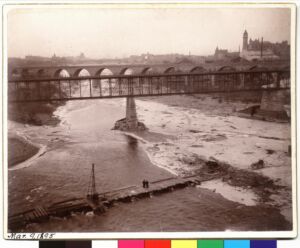Explore Hennepin County History Online with the Minnesota Digital Library
By Stephanie Hess, Minnesota Digital Library Digital Curator

St. Anthony Falls milling district with trestle bridge and Stone Arch Bridge, Minneapolis, 1895.
The Minnesota Digital Library (MDL) contains digitized content from Minnesota’s cultural heritage organizations in a single website. Over 200 participating organizations, including the Hennepin History Museum, have contributed photographs, documents, maps, recordings, and more to MDL’s free searchable online database. Simply put, MDL is full of historical resources just waiting to be discovered by people all over the state. Here are some ways you can engage with these digital collections online.
Browse and Search
To get started, visit the MDL website at mndigital.org. You can browse all items, or you can browse by topic, contributor, or format. Use the Search bar, located at the top of every page, to search for something specific. MDL has both a basic search as well as an Advanced Search, where you can limit results or have more than one search term.
Access the Hennepin History Museum Collection
There are two ways to access the digital collection of an organization in MDL. First, use the “About” drop-down menu to select “Contributing Organizations,” then search for the Hennepin History Museum. Alternatively, you can view the Hennepin History Museum’s digital collection using the “Browse by Contributor” button on MDL’s home page.
Here are some highlights from HHM’s collection to explore:
- Views of the St. Anthony Falls apron on the Mississippi River in Minneapolis.
- A photograph album containing mounted portraits of Minnesota Volunteers during the Civil War, identified by name and rank.
- Cyanotypes of construction and manufacturing projects along the Mississippi River.
- A letter from Booker T. Washington at the Tuskegee Institute to a Minneapolis church leader.
- Photographs documenting the Hennepin Island generator and water power station
- A receipt for the sale of an enslaved person in Massachusetts from the 1700s. Learn more about this document in HHM Archivist Michele Pollard’s section of MDL’s Contributor’s Choice online exhibit.
- Collection of lantern slides used by Arthur Adams, a Minneapolis high school teacher, local historian, and photographer, who traveled the state and lectured on Minnesota history topics in the 1920s. Subjects include significant historical and natural sites across the state, notable early Minnesotans, and scenes of Minneapolis.
- A collection of photographs taken by Ernes A. Kjorlie from the 1930s, who captured scenes from the city at night, shopping districts, the Benny Goodman Trio, railroads, and a Winter Carnival ice palace.
Timelines and Maps
Timelines are useful tools for learning about people, places, and events in the past. MDL has created a variety of online timelines that place historical images, documents, maps, and more at specific moments in time. Explore these timelines to engage with MDL’s digital collections in a new way, particularly the two-part Minnesota history timeline. You can view the timelines on MDL’s Timelines Project Page.
MDL has also developed several online story maps that place MDL materials in their actual locations within Minnesota. Each map features photographs and documents that help tell stories about these significant places. Access the maps on MDL’s Maps Project Page.
Two of MDL’s maps include locations in Hennepin County. Check them out:
- Carnegie Libraries map
- Mississippi River map
Primary Source Sets
Are you a teacher who is looking for new ways to help students develop critical thinking and historical analysis skills? Have them “Think Like a Historian” with Primary Source Sets from the Minnesota Digital Library. These sets bring together primary and secondary sources in new ways to help students better understand historic events in their context.
Drawing on materials shared with MDL by libraries, archives, and museums across Minnesota, these sets include letters, photographs, advertisements, oral histories, postcards, newsletters, speeches, and more. Each set includes a topic overview, ten to twenty primary sources from MDL collections, links to related resources, discussion questions and classroom activities. There are 38 Primary Source Sets available for free on the MDL website.
Several of MDL’s sets feature Hennepin County-related history, including:
- Construction of the Apron at St. Anthony Falls
- Flour Milling in Minnesota
- Minneapolis Teamsters Strike of 1934
- St. Anthony Falls
- Twin Cities Streetcars
Online Exhibits
Finally, explore MDL’s Online Exhibits to learn about a wide range of topics in Minnesota history and culture. These carefully curated exhibits add historical context to MDL’s rich collections of digitized materials. They provide an opportunity for visitors to discover and engage with the stories preserved in MDL on a deeper level. Exhibit subjects include Minnesota immigrants, war stories, agriculture, and significant people, places, and events.
MDL is pleased to offer access to these wonderful examples of local history tools that enable you to dig deeper into the past.
